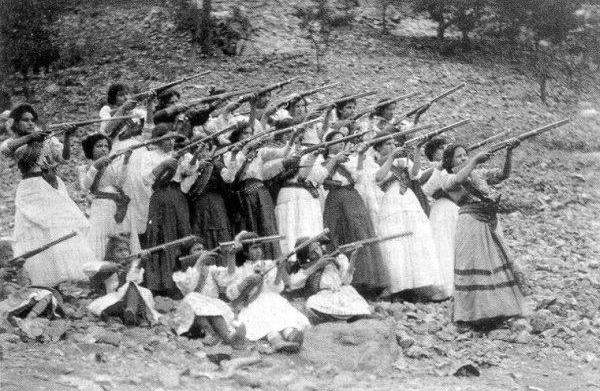Winner of the Spring 2018 StMU History Media Award for
Best Article in the Category of “Gender Studies”
“La Adelita” was one of the most popular corridos, or songs of romance, during the Mexican Revolution (1910-1920).1 This song is the love story of a young woman who travels with a sergeant and his regiment during the revolution.2 The song praises Adelita, the sweetheart of the troop, for both her beauty and her valor, noting how she is wanted by the other soldiers. We can imagine this woman as an object of desire, whose beauty and physique attracted the soldiers, and eventually broke their hearts. But this description is actually… incorrect.3
The Adelita, also known as soldadera, or female soldier, is the term used to describe women who contributed to many aspects of the Mexican Revolution. These women worked as nurses, food providers, lovers, spies, messengers, and fighters.4 In fact, some reached the rank of colonel and general. Many of them were forced by their husbands to follow them and work in the camps, but there were also those who volunteered to join the cause.5 Today, soldaderas are remembered as strong and courageous women who took up weapons and became fighters, often having to cut their hair and dress to appear like their male counterparts, because of the oppressive gender inequality prevalent in the Mexican society of that time.6 There is one soldadera in particular, Petra Herrera, also known as La Guerrera, and as La Generala (female general), who joined the cause and fought with the strongest of the soldiers. But what inspired women to join their male counterparts to fight this war, and why did the revolution even happen?

To answer this question and to be able to understand why these women now make up a very important aspect of Mexico’s history and its formation as a country, we need to go back in time to 1876, when the general and politician Porfirio Díaz became president. Porfirio Díaz was known to be a corrupt, elitist president, who favored wealthy landowners, industrialists, and foreign interests.7 The country was also known for the slave-like conditions rural people faced while working on the haciendas owned by wealthy landowners.8 These rural workers were very dissatisfied with the lack of voice they had in the government. But the precipitating event that sparked the revolution was Díaz’s announcement, in 1908, that he would run for his seventh term as president in 1910. This caused controversy among the people who had been suffering from his long regime. Francisco I. Madero then rose as the leader of the Antireeleccionistas (Anti-Reelection alliance). Madero subsequently announced that he would be running for president against Díaz. This prompted the mobilization of armies throughout Mexico. Countless leaders, such as Pascual Orozco and Pancho Villa, began raiding government garrisons as part of an uprising to remove the current president and eventually, elect a new president for the country.9 These were some of the events that inspired and sparked the courage of not only men but of women as well, to join the armies and fight for the shared goal of overthrowing Díaz’ dictatorship and make democracy in Mexico a reality.10

Petra Herrera witnessed the suffering of her country and decided to take action. She witnessed the harshness of landowners and the terrible conditions in which workers lived. She knew that the government had to change from being a corrupt one to being a democratic and fair one. But how would she help? Women at that time faced strict social prohibitions that kept them from playing important roles in the workforce. Instead, they were expected to be caregivers, stay at home, and take care of their children. Women were seen as precious and delicate, something that could not blend with the harshness of war. Petra, instead of following that norm, disguised herself as a man and started calling herself “Pedro Herrera” in order to join the revolutionary troops of Pancho Villa.11
During her time in the camp, she had to lie to her fellow soldiers in order to protect her identity. For example, she would lie that she shaved at dawn before the other soldiers woke up.12 Because of this, “Pedro” was able to blend in perfectly. Quickly after her joining the army, Petra was recognized as an aggressive fighter who carried out military operations efficiently and strategically. In disguise, she came to be known as a courageous and brave soldier, and was soon praised for her intelligence and her skills at blowing up bridges.

Thanks to the acknowledgment she faced on behalf of her peers and her establishment as a strong soldier, Petra decided she would confess her true identity. She believed this would not affect her position or status in the militia, and that she would be accepted and even promoted to general. But sadly, when she told the truth, she was removed from the army instead.13 Consequently, she decided to organize a group of women who were likewise removed from combat, even after they had fought courageously for the same cause as their male counterparts. Petra decided not to give up, and she organized a group of more than four hundred women with the same motive: to put an end to the current presidency and the hardships that Díaz had imposed on the citizens. Her militia not only fought in several battles, but Petra united these fighting women with Pancho Villas’ forces, despite his denial of them fighting and bearing arms. Together, they were able to take the city of Torreón on May 30, 1914, which had been a military base for Díaz’s central federation.14 At the end of the fight, she requested General Castro, a leader of the revolution, to allow her to re-enter the military and make her general, but he only granted her the title of colonel and disbanded her woman’s brigade.15 But her work did not end there. After the demobilization of the woman’s militia, Petra decided to join Venustiano Carranza, one of the main political leaders of the revolution who later became president of Mexico. She became a spy for him and worked as a bartender in Jimenez, a city in the northern part of Mexico.16 But while she was working there, she was shot three times by a group of drunk men, later dying from the injuries.
Despite the effort and the work Petra Herrera gave for the revolution, she has barely received any acknowledgment as a soldadera. There are several causes for this. Men during those times had mixed feelings about women being in combat and the role they had in the fight.17 One of the most passionate opponents of women joining the militia and bearing arms was Pancho Villa. He viewed women as liabilities to an army’s offensive strategy and combative potential, even though Petra Herrera and other great female combatants fought at his side several times to free the country from the oppressive presidency.18 There was also the idea that soldaderas were just images of romance during the Mexican Revolution, such as the song of “The Adelita,” contributing to recognizing only a few of them as strong fighters and contributions to this era.19 These women should be acknowledged and we should grant them a higher praise because many were forced to take this role of soldaderas after being abducted and often raped by revolutionaries who invaded their towns and cities. At the end of the day, the labor and effort of women such as Petra were very important factors for what we have come to know as the Mexican Revolution.
Hear the ballad of La Adelita
La Adelita
Spanish20
Little Adela
English translation21
- Beatriz de León, “La Adelita: El Rostro de La Soldadera,” in Reforma (Mexico D.F., Mexico), 2010. ↵
- Beatriz de León, “La Adelita: El Rostro de La Soldadera,” Reforma (Mexico D.F., Mexico), 2010. ↵
- Andrés Reséndez Fuentes, “Battleground Women: Soldaderas and Female Soldiers in the Mexican Revolution,” The Americas, no. 4, (1995): 55-57. ↵
- Oxford Research Encyclopedias, May 9, 2016, s.v. “Working Women in the Mexican Revolution,” by Susie S. Porter. ↵
- Donna Seaman, “Las Soldaderas: Women of the Mexican Revolution,” Booklist 103, no. 12, (2007): 18. ↵
- Elizabeth Salas, Soldaderas in the Mexican Military: Myth and History (Austin, Tex.: University of Texas Press, 1990), 48-49. ↵
- Encyclopedia Britannica, October 25, 2017, s.v. “Mexico | History, Geography, Facts, & Points of Interest – The Mexican Revolution and Its Aftermath.” ↵
- Encyclopedia Britannica, January 2, 2018, s.v. “Mexican Revolution | Causes, Summary, & Facts.” ↵
- Encyclopedia Britannica, January 2, 2018, s.v. “Mexican Revolution | Causes, Summary, & Facts.” ↵
- Encyclopedia of Latin American History and Culture, January 2008 v.s. “Women,” by Francesca Miller and Meredith Glueck. ↵
- Delia Fernandez, “‘La Adelita’ Becomes an Archetype of the Mexican Revolution,” McNair Scholar Journal, Vol. 13, (2009): 57-58. ↵
- Jason Porath, Rejected Princesses: Tales of History’s Boldest Heroines, Hellions, and Heretics, (New York, NY.: Patreon, 2016), 123-124. ↵
- Elena Poniatowska, Las soldaderas: women of the Mexican revolution (El Paso: Cinco Punto Press, 2006), 45. ↵
- Encyclopedia Britannica, October 25, 2017, s.v. “Mexico | History, Geography, Facts, & Points of Interest – The Mexican Revolution and Its Aftermath.” ↵
- Jason Porath, Rejected Princesses: Tales of History’s Boldest Heroines, Hellions, and Heretics, (New York, NY.: Patreon, 2016), 123-124. ↵
- Jason Porath, Rejected Princesses: Tales of History’s Boldest Heroines, Hellions, and Heretics, (New York, NY.: Patreon, 2016), 123-124. ↵
- Wilma Mankiller, Marysa Navarro, and Gloria Steinem, “Feminism and Feminisms: Feminism,” in Reader’s Companion to U.S. Women’s History (Boston, 1998), 187. ↵
- Oxford Research Encyclopedias, May 9, 2016, s.v. “Working Women in the Mexican Revolution,” by Susie S. Porter. ↵
- Alicia Arrizón, “Soldaderas and the Staging of the Mexican Revolution,” TDR: The Drama Review 42, no. 1, (1998): 105–107. ↵
- Amparo Ochoa, “La Adelita,” Corridos Y Canciones de la Revolucion Mexicana, Ediciones Pentagrama, 1995. Featured in video “La Adelita – Amparo Ochoa,” Courtesy of Youtube (https://www.youtube.com/watch?time_continue=64&v=hlGtOv-QEQQ ). ↵
- “La Adelita,” Mexican Folk Song, translation of last three stanzas by phantasmagoria ↵




127 comments
Jose Maria Gallegos Cebreros
Hi, first of all congrats on the great article and in your award. I really like how you talk about the Adelitas, I think they are such an important part of the Mexican Revolution. I really enjoyed reading your article, you used a great article that makes it easy understand and the information is very clear. It shows how much time and effort you put on this article. Congrats!
Lauren Deleon
I think it is so interesting that throughout history in all different parts of the world there are stories like this one. Where women join a military cause by disguising themselves as men in order to earn respect and the ability to occupy spaces they would otherwise be barred from. I had never heard the story of Petra, so thank you so much for telling it in such a compelling way.
Melyna Martinez
This article shows the fight for change in Mexico and how women want to change and break norms, especially in Mexican culture where norms are very highlighted. The story of Petra I believe showcases how historically women have fought for equality. Being a women soldier during this time came with its hardships, and to be scared to be looked out for just being a woman must have been hard. This is why movements such as this one can have so much power to bring change, it is sad not many know of her story or of people like her.
Alanna Hernandez
Love,love,love! Las soldaderas played a huge role in the Mexican Revolution that till this day won’t be fully recognized as they weren’t given the voice then and therefore robbed of it now. The idea of a revolutionary, who is for progression, still saw women as a second being, behind men. And therefore unable to utilize them in times of need. It reminds me of las patronas today, who are helping those migrating from South America by throwing food onto passing trains. I only wish the music was able to play from the beginning as we read the article.
Eugenio Gonzalez
First of all, congratulations on your winning article. The author does an excellent job of explaining why Petra Herrera and other women decided to fight in the Mexican revolution. I like how the author introduces the term ”Adelita” and explains what it means and why they would call them that. Even though Petra Herrera and other women were discriminated against, they continue to fight for what they believe in, which I consider admirable.
Jaedon E
Great article! I love how detailed the article was. What I found interesting was how the army acted when they found out she was a female instead of a male. What this reminded me of was the movie Mulan, when the army found out Mulan was a female they were all discouraged but then changed their mind and decided to allow her to continue to fight beside them. How this relates to Pedro is that the army disregarded her, after all the successful missions she oversaw. As well as her insightful military strategics.
Overall great article!
Maria Delia Garcia
My 87th year old aunt, mentioned that her aunts who were born in the late 1800’s were dressed for combat with rifles strapped to their shoulders. This is a story that her mom, which is my grandmother, talked about. In seeing the video, I couldn’t help but to think, what if one of those women were one of my relatives. There were 9 girls. Thanks for bringing this to light and knowing that our ancestors were defenders in what they believed in.
Nicholas Quintero
great article! the pacing of this article and how it flowed was very nice. from the beginning which defines and gives context to what the article is discussing and then following up with a flashback that begins the story is a great way to engage and hook the reader. The story of continuing to fight despite being discriminated against and how they made their mark on history is told wonderfully by the author and I enjoyed all of it.
Andrea Ramirez
Hi Regina,
I really liked how you wrote your article, I really think it was very informative.
When talking about the Mexican Revolution, the role that women played in it, which was fundamental, is often overlooked. I knew about the soldaderas, but I didn’t fully understand the role that, for example, Petra Herrera played. I was very surprised that she pretended to be a man, so she could be part of the cause. But I was even more mystified that despite her being recognized as an “aggressive fighter who carried out military operations efficiently and strategically”, she was removed from the army simply for being a woman.
So, I totally agree with you that the soldaderas should be recognized and praised for their important role in the Mexican Revolution.
Finally, I want to mention that I really liked the images you added of the soldaderas in the war, and of Petra Herrera herself, as they perfectly complemented your article. I also think it was a great detail that you put the lyrics of Adelita’s song and the video because that way the readers can better understand the context of your article.
Congratulations on your award, it is well deserved.
Jesslyn Schumann
First, I would like to congratulate you on winning an award for this paper! It is beautifully written. Prior to reading this, I had no idea who Petra Herrera was and what a Adelita was. Upon reading this, Petra’s story sounded extremely similar to that of Mulan. I love the way you highlighted all of her accomplishments and her life in general. She is a very important woman in history when it comes to on the battle field.